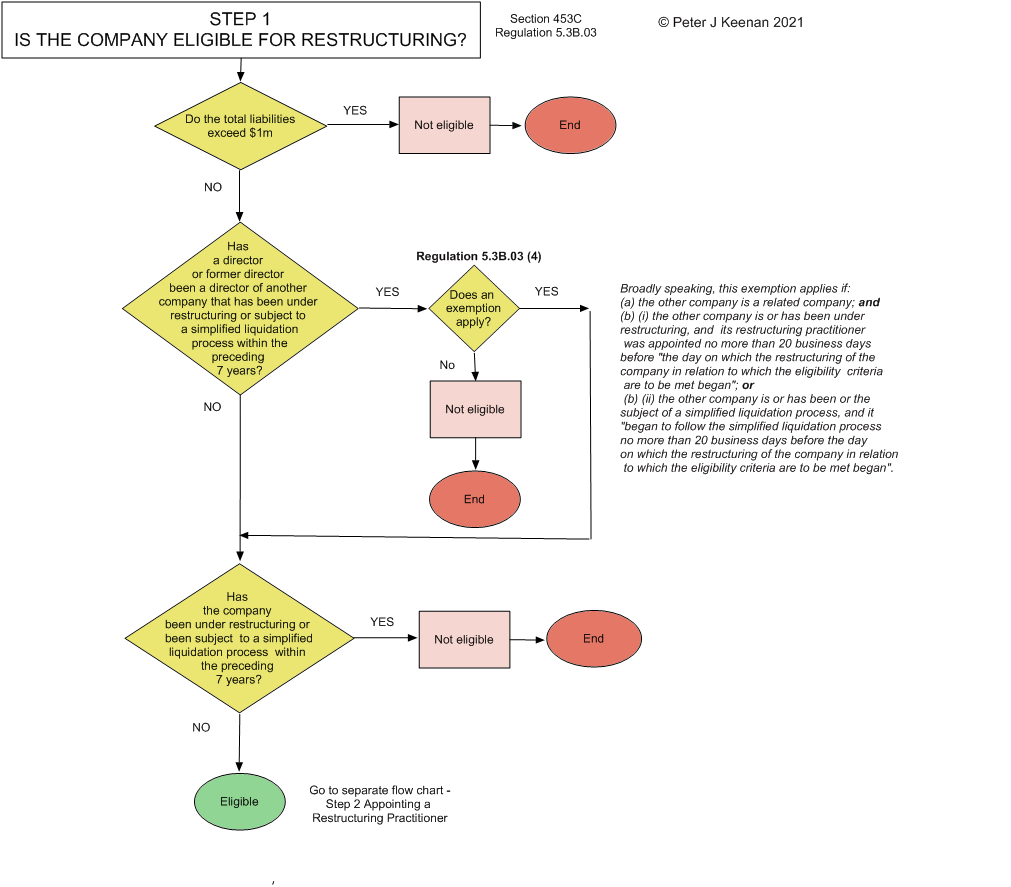Creators of ASIC’s ROCAP documents describe their process
Creators of ASIC’s ROCAP documents describe their process
Soon after the Australian Securities and Investments Commission (ASIC) issued a form titled “Report On Company Activities and Property“ (ROCAP), the creators of the form – the Communications Research Institute (CRI) – published an article describing the process they went through, their standards and the results of tests carried out.
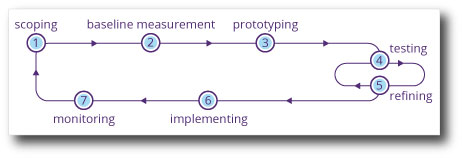
CRI form design procedure (Source: CRI)
The ROCAP – which replaced the Report as to Affairs (RATA) – is used in corporate insolvencies, where company directors are required to supply liquidators and other external administrators with details of a failed company’s present position, assets, liabilities and history.
Below is a copy of the article written in October 2018 by the head of CRI, Professor David Sless.
As the reader will see, CRI reports that “in the final round of testing (of the new form/documents) participants described the documents as ‘straightforward’ (and that) they easily followed both instructions and the related form-filling task.”
If that’s how the form and accompanying documents are received and processed in practice, it will be a welcome change. Because, by contrast, CRI says it found that “not a single director who participated in the CRI testing of the original RATA could use it appropriately”.
By now (June 2019) feedback to ASIC should indicate whether the new design developed by CRI has been a success, i.e., is regarded by directors and liquidators as more user-friendly and useful. CRI says that “once introduced, the forms and instructions will be carefully monitored and further refined or changed as needed.”
A NEW FORM HELPING FAILED COMPANIES
A Communications Research Institute (CRI) Model projectWHEN A COMPANY fails and an External Administrator is appointed, the Administrator sends a director of the company a form to complete by a set date. The form, known until now as the Report As To Affairs (RATA) had remained largely unchanged since the 19th century. The Australian Securities and Investment Commission (ASIC), which issues the RATA under the Corporations Act 2001, contracted CRI to develop a new design that would be:
- user friendly,
- consistent and logical,
- visually appealing,
- easy to read an complete.
CRI drew on its extensive research and practice in forms design spanning over three decades. CRI collaborated and consulted throughout the project with ASIC and a diverse group of professionals, academics, industry bodies, and former company directors, all of whom contributed to the design of the new form.
External administrators, in particular, who were the main RATA users told us that it failed to provide them with adequate information on the companies they administered. CRI, in consultation with ASIC determined that the needs of administrators had to be taken into account in the redesign.
Receiving the RATA is an unhappy and often traumatic experience for company directors. It marks the end of the company’s life, handing over its remains and final fate to an External Administrator who disposes of it and its assets in the best interests of its creditors. The feedback showed that in that handing over, filling out the RATA was itself traumatic.
Tellingly, not a single director who participated in the CRI testing of the original RATA could use it appropriately.
The redesign involved all aspects of the form’s structure, language, layout, colour and content, and a change of name from RATA to are more easily understood name: ROCAP – Report on Company Activities and Property. CRI undertook three rounds of designing, testing, and consultation with ASIC and stakeholders, followed by redesign.
The result is a totally new set of three documents to replace the RATA: Part A contains most of the RATA questions but in a totally new format, Part B contains new questions about the company records, history and management, and the third document contains detailed instructions for completing Parts A and B….
The instructions … are designed to exactly complement the questions, using the same numbering system throughout.
Observations from previous research shows that form users avoid reading instructions on a form because they see the task is primarily a form-filling task rather than are reading-and-form-filling task. In CRI’s designs, the instructions are always in a separate document, physically removed from the form filling tasks.
Careful design refinement of the navigation between the two documents as a result of testing enabled easy navigation between the two. In the final round of testing, participants describe the document as “straightforward”. They easily followed both instructions and the related form-filling task. The new design meets all CRI standards for good information design.
Once introduced, the forms and instructions will be carefully monitored and further refined or changed as needed.
Professor David Sless
Communication Research institute – October 2018
My previous posts on this subject are titled “Framework of new Report as to Affairs (RATA) drafted by ASIC” and “ASIC notifies liquidators that ROCAP is to replace RATA”.
I plan to post more articles about the new form and documents.
ASIC notifies liquidators that ROCAP is to replace RATA
In an email to liquidators on 1 November 2018 the Australian Securities and Investments Commission has notified liquidators that its Report as to Affairs (RATA) form – Form 507 – is to be replaced by its new Report On Company Activities and Property (ROCAP) form – which comprises a new Form 507 plus a questionnaire. Directors and officers of companies entering into insolvent administration are required to complete the form and questionnaire.
Liquidators have been asked to issue the new ROCAP to directors for all new External Administrations after 1 November 2018, but says there will be a three-month transition period to allow software providers to catch up with the change.
A copy of the email is reproduced below.
For more about the new form and questionnaire, see my post “Framework of new Report as to Affairs (RATA) drafted by ASIC” (19/10/2018).
The new forms are available from ASIC: click HERE for the new ROCAP and HERE for the Instructions.
Email from ASIC to Registered Liquidators, 1 November 2018:
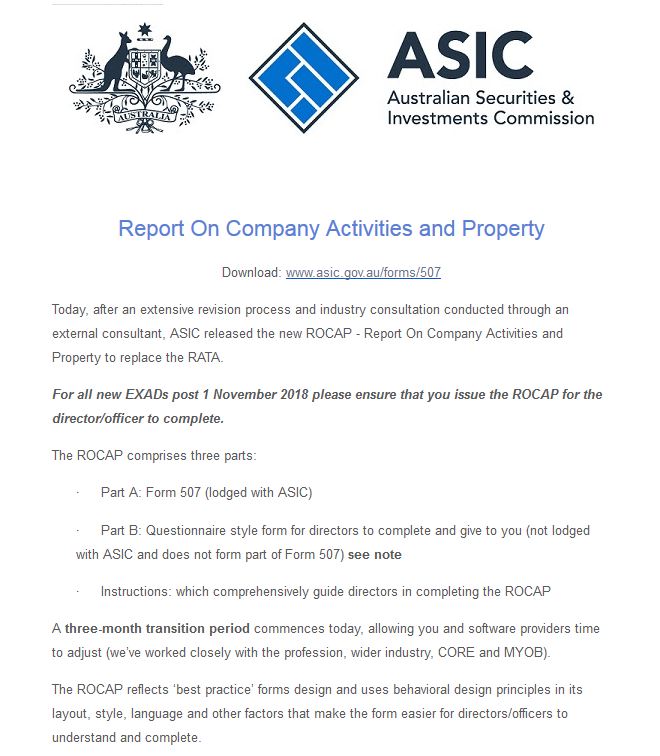
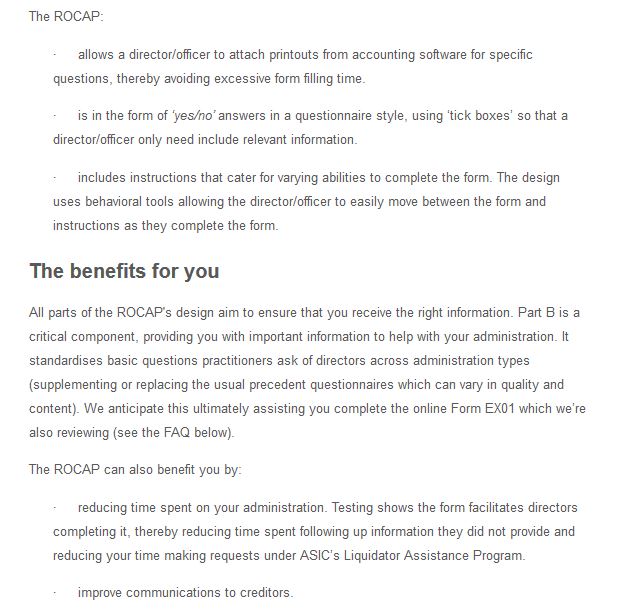


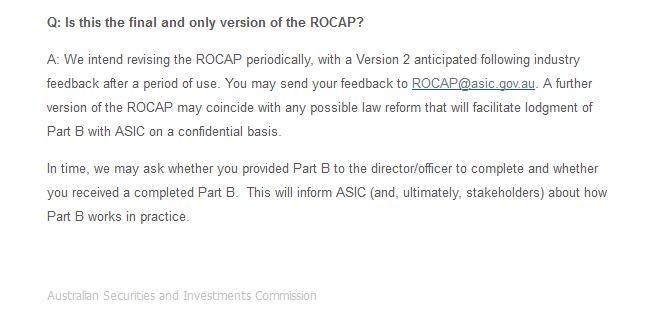
For more in this subject see my post of 22 June 2019: “Creators of ASIC’s ROCAP documents describe their process.”
Framework of new Report as to Affairs (RATA) drafted by ASIC
![]() On 1 October 2018 the Australian Securities and Investments Commission (ASIC) released a draft of a new Report as to Affairs (commonly known as a RATA). A copy of this form, which includes detailed instructions, may be downloaded from my website or from this ASIC journal.
On 1 October 2018 the Australian Securities and Investments Commission (ASIC) released a draft of a new Report as to Affairs (commonly known as a RATA). A copy of this form, which includes detailed instructions, may be downloaded from my website or from this ASIC journal.
The new name of the report is to be Report On Company Activities and Property (ROCAP). ASIC intends releasing it in November 2018.
Analysis

The following comments outline my preliminary analysis of the draft. Continue reading »
ASIC reissues some of its insolvency information sheets

With the commencement on 1 September 2017 of the delayed parts of the Insolvency Law Reform Act 2016 (the ILRA), the Australian Securities and Investments Commission (ASIC) has updated some of the Information Sheets which it makes available on its website to the general public.
ASIC says that “Information sheets provide concise guidance on a specific process or compliance issue or an overview of detailed guidance.”
Over time ASIC has issued about 36 insolvency information sheets and flow charts (click here for my list). Below is a list of 15 which have recently been reissued.
In the past, nearly all ASIC’s information sheets have been available to download as printable sheets in PDF file format. However, this facility has not (yet) been provided with the updated/reissued sheets, which are only available as text on ASIC web pages. The links below are to the relevant website pages.
ASIC INSOLVENCY INFORMATION SHEETS – REISSUED 1 SEPTEMBER 2017 |
|||
Form Number |
Title of Sheet |
Date Updated |
Link to ASIC site |
| INFO 39 | Insolvency information for directors, employees, creditors and shareholders |
1/9/2017 |
INFO 39 |
| INFO 41 | Insolvency: A glossary of terms | 1/9/2017 | INFO 41 |
| INFO 42 | Insolvency: a guide for directors | 1/9/2017 | INFO 42 |
| INFO 43 | Insolvency: a guide for shareholders | 1/9/2017 | INFO 43 |
| INFO 45 | Liquidation: a guide for creditors | 1/9/2017 | INFO 45 |
| INFO 46 | Liquidation: a guide for employees | 1/9/2017 | INFO 46 |
| INFO 53 | Providing assistance to external administrators – Books, records and RATA | 1/9/2017 | INFO 53 |
| INFO 54 | Receivership: a guide for creditors | 1/9/2017 | INFO 54 |
| INFO 55 | Receivership: a guide for employees | 1/9/2017 | INFO 55 |
| INFO 74 | Voluntary administration: a guide for creditors | 1/9/2017 | INFO 74 |
| INFO 75 | Voluntary administration: a guide for employees | 1/9/2017 | INFO 75 |
| INFO 84 | Independence of external administrators: a guide for creditors | 1/9/2017 | INFO 84 |
| INFO 85 | Approving fees: a guide for creditors | 1/9/2017 | INFO 85 |
| INFO 152 | Public comment on ASIC’s regulatory activities | 1/9/2017 | INFO 152 |
| INFO 212 | Illegal phoenix activity | 1/9/2017 | INFO 212 |
Practitioners’ association updates insolvency information for stakeholders
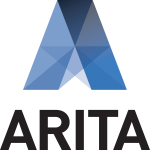
With the commencement on 1 September 2017 of the delayed parts of the Insolvency Law Reform Act 2016 (the ILRA), the Australian Restructuring Insolvency & Turnaround Association (ARITA) has updated the Insolvency Explained section of its website which provides information to stakeholders in the insolvency process, and has developed a range of information sheets designed to assist creditors with understanding insolvency processes.
This is a guide to ARITA’s information, with links to the relevant website pages.
1. Insolvency explained CLICK HERE
-
What is insolvency? CLICK HERE
- Overview of insolvency – corporate
-
What is bankruptcy? CLICK HERE
- Overview of insolvency – personal
-
How does insolvency work? CLICK HERE
-
Insolvency and creditors CLICK HERE
-
Insolvency and employees CLICK HERE
-
Insolvency and shareholders CLICK HERE
-
Insolvency and company directors CLICK HERE
-
Insolvency information sheets see section 2 below
-
Glossary of terms CLICK HERE
2. ARITA insolvency information sheets
The ARITA insolvency information sheets listed below may be downloaded from the page headed “Insolvency information sheets”. They are all in PDF format. ….. CLICK HERE
Company insolvency
- Creditor rights (liquidation)
- Creditors rights (voluntary administration)
- Remuneration of an external administrator
- Proposals without meetings
- Committees of Inspection
- Offences and recoverable transactions in a voluntary administration
Personal insolvency (including bankruptcy)
- Creditor rights
- Proposals without meetings
- Committees of Inspection.
A short history of the ILRA
The ILRA reform provisions relating to the rules and conduct of external administrations, commenced on 1 September 2017. This followed ILRA reform provisions relating to the registration and discipline of registered liquidators, and provisions relating to matters such as notification of contravention of a Deed of Company Arrangement and lodgement of a declaration of relevant relationships and declaration of indemnities in a voluntary administration, which commenced on 1 March 2017.
Parliament passed the Insolvency Law Reform Act 2016 (the ILRA) on 22 February 2016. The government registered the related Insolvency Practice Rules (Corporations) 2016 (the Rules) in December 2016. The ILRA and Rules change the law relating to the registration and discipline of liquidators and the conduct of external administrations.
It’s not the Court’s function to apply or interpret ARITA’s code – Judge
What His Honour said – extracts:
There is no doubt that the code is a useful document in assisting practitioners; …. it is “a useful guide to the common practice in such matters, and to the profession’s own view of proper professional standards”; …. it is “… permissible for the Court to take [it] into account, to that extent, in applying the law concerning independence and impartiality to the insolvency practitioner’s conduct in the case before it”; …. On the other hand, the code “has no legal status”; …. Any question relating to the appearance of impartiality must be determined according to law. It is not the Court’s function in a case such as this to either apply or interpret the code.
For more, see his complete comments below.

The Hon David John O’Callaghan
Judgment published 11 August 2017 … In Korda, in the matter of Ten Network Holdings Ltd (Administrators Appointed) (Receivers and Managers Appointed) [2017] FCA 914
….
The code of professional practice
92. I should also say something briefly about the Code of Professional Practice of The Australian Restructuring Insolvency and Turnaround Association (ARITA) (the code), because the administrators sought to rely on the code as providing an independent basis upon which they might be permitted to continue to act as administrators. In particular, submissions were made on behalf of the administrators about those parts of the code which define “exceptions” to the “rule” that, relevantly, practitioners must not take an appointment if they have had a professional relationship with the insolvent company during the previous two years: see section 6.8 of the third edition of the code.
93. There is no doubt that the code is a useful document in assisting practitioners, including with respect to questions of whether, in accepting or retaining an appointment as an administrator, the practitioner is, and is seen to be, independent: see chapter 6 of the third edition of the code. The code is intended to provide guidance on standards of practice and professional conduct expected of ARITA members.
94. In Bovis Lend Lease Pty Ltd v Wily [2003] NSWSC 467; 45 ACSR 612, Austin J described (at [163]) the Code of Professional Conduct published by the Insolvency Practitioners Association of Australia (as ARITA was previously known) as “a useful guide to the common practice in such matters, and to the profession’s own view of proper professional standards”. Accordingly, his Honour held that “[i]t is permissible for the Court to take [it] into account, to that extent, in applying the law concerning independence and impartiality to the insolvency practitioner’s conduct in the case before it”: see Bovis Lend Lease Pty Ltd v Wily [2003] NSWSC 467; 45 ACSR 612 at [163]; comparing National Roads and Motorists’ Association Ltd v Geeson [2001] NSWSC 832; 39 ACSR 401 at 403 and Permanent Trustee Australia Ltd v Boulton & Lynjoe Pty Ltd (1994) 33 NSWLR 735 at 738.
95. On the other hand, the code “has no legal status”, as Sanderson M stated in Monarch Gold Mining Co Ltd; Ex parte Hughes [2008] WASC 201. Relevantly, Sanderson M observed in that case, “a failure to comply with the terms of the code would not render a practitioner liable for prosecution under the Corporations Act or any other statute … Nor does a failure to comply with the provisions of the code mean that there has been a failure to comply with what is required in the DIRRI”: see Re Monarch Gold Mining Co Ltd; Ex parte Hughes [2008] WASC 201 at [37].
96. Any question relating to the appearance of impartiality must be determined according to law. It is not the Court’s function in a case such as this to either apply or interpret the code.
ASIC catalogues where a liquidator failed to perform his duties
In reporting on the results of an investigation into the conduct of a Victorian registered liquidator operating as a sole practitioner, the Australian Securities and Investments Commission (ASIC) has provided a list of procedures which the liquidator failed to carry out.
The catalogue serves both as a guide to some of the duties that ASIC regards as important, and as a reminder to liquidators.

Extract from ASIC Media Release 28 June 2017
ASIC’s concerns centred on alleged failures to:
- conduct pre-appointment independence reviews;
- send to third parties adequate ‘Day One’ correspondence;
- properly investigate company affairs;
- take steps to protect and secure assets in a timely manner;
- adequately investigate potential illegal phoenix activities and taxation offences of directors and their advisors;
- make sufficient requests of company officers for books and records;
- seek prompt assistance from ASIC under the Liquidator Assistance program where the company director or accountant failed to provide adequate books and records;
- undertake adequate review of voidable transactions, including unfair preferences and uncommercial transactions;
- lodge complete reports with ASIC;
- provide creditors with adequate reporting to enable informed assessment of remuneration requests and may have drawn remuneration he was not entitled to; and
- comply with legal requirements to document work undertaken.
Not each and every one of ASIC’s concerns were found in all of the external administrations reviewed.
ASIC Commissioner John Price said, ‘ASIC continues its focus on registered liquidators who fail to carry out their legal obligations to carry out adequate investigations and report fully to creditors, including in circumstances suggesting pre-appointment illegal activity.
‘Creditors have every right to expect registered liquidators to act independently and competently – especially given their role as a fiduciary. The community needs to have trust and confidence in the administration of insolvent companies.
‘ASIC will continue to review and take action against liquidators whom ASIC believes fall short of meeting legal and professional standards.’
Law change is significant win for insolvency practitioners
Before it is due to come into effect on 1 September 2017, section 60-20 of the Insolvency Practice Schedule (Corporations) (Australia) is to be amended.
Under the heading “Refining the Insolvency Law Reform Act 2016”, the Minister for Revenue and Financial Services has released draft legislation of amendments to the Corporations Act 2001 and Bankruptcy Act 1966.
The professional association representing insolvency practitioners has welcomed the amendments. The Australian Restructuring Insolvency & Turnaround Association (ARITA) says (on its website 5/5/2017):
The section would (have) require(d) external administrators and trustees to obtain consent from creditors prior to related entities obtaining any profit or advantage from any administration or estate – effectively requiring Insolvency Practitioners to seek creditor approval for their own firms to work on an appointment. We are delighted that Treasury have announced draft legislation specifically to resolve this issue. It is now clear that once remuneration is approved, further approval to share that remuneration with related parties (e.g. an Insolvency Practitioner’s firm or partners) is not required …. ARITA has been working very hard behind the scenes on this under strict confidentiality. The draft legislation is on The Treasury’s website for consultation. This is a significant win for the profession, achieved by ARITA.
Illustration of Change to Corporate Insolvency Law
I have set out below an illustration of the changes that are being made to section 60-20 of the Insolvency Practice Schedule (Corporations). Although “interested parties” have been invited to make a submission regarding the draft legislation by 17 May 2017, it is doubtful whether there will be any change to the draft. Continue reading »
New Corporate Insolvency Laws commencing 1 March 2017
Commencing on 1 March 2017 are some of the changes to Australia’s corporate insolvency legislation that were approved when the Insolvency Law Reform Act was passed in 2016. The Australian Securities and Investments Commission (ASIC), the regulator of the Corporations Act, has issued a table listing and summarizing what it says are the key changes. Set out below is a copy of that table. (The original is available to view at ASIC).
For a convenient list of NEW ASIC FORMS and AMENDED ASIC FORMS go to this EMAIL extract from ASIC to registered liquidators on 6 March 2017. NOTE: Some of the new and amended forms have not yet been released by ASIC (7/3/2017).
Corporate Insolvency Law Reform – key changes effective from 1 March 2017
Subjects
- Registration Process
- Industry wide conditions
- Applying to vary or remove a condition or to lift or shorten a suspension
- Renewal of registration
- The Liquidator Register
- Insurance
- Annual liquidator return
- Notice of significant, and other, events
- ASIC power to direct registered liquidator to lodge documents or give information or correct inaccuracies
- ASIC power to cancel or suspend a person’s registration
- Disciplinary action by a committee
- Notice by industry body of possible grounds for disciplinary action
- Court oversight of registered liquidators
- Registration and disciplinary committees
- Administrator’s notice to owner or lessor of property
- Notice – material contravention of deed of company arrangement
- Company’s former name
- Relation back day
- Lodging declarations of relevant relationships and indemnities
- Lodgement requirements relating to pooled groups
